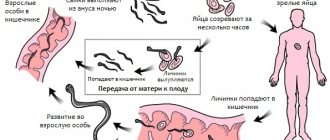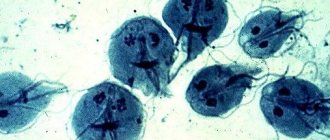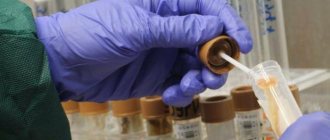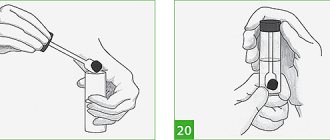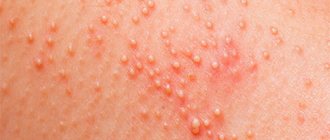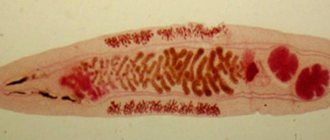General analysis
It is one of the basic tests required when visiting many specialists.
General analysis among specialists may also be referred to as “clinical”, or bear the abbreviation KLA. It is a whole set of tests aimed at determining both the quantity and parameters (size, etc.) of various blood cells.
The test allows blood sampling from both a vein and a finger (capillary).
Indications for use, preparation for the study
This is one of the most common laboratory tests performed to assess the general health of a patient. Prescribed for routine medical examinations, preparation for surgery, and included in the medical commission.
Symptoms for which a doctor may prescribe OAC: complaints of fatigue, weakness, apathy, signs of an infectious disease or inflammation, and elevated body temperature. A timely test allows you to diagnose and promptly treat a whole range of serious diseases.
The results of your analysis will be as reliable as possible if, before taking it, you:
- the day before your visit to the clinic, exclude alcohol and medications from your diet (in consultation with your doctor);
- You will not take it for 8 hours before the test (you can drink still water);
- Half an hour before donating blood, it is advisable not to overexert yourself physically and emotionally. Try not to smoke either.
General blood test indicators
The blood test includes a number of parameters. First of all, this is the calculation of the number of red blood cells (oxygen transport), leukocytes (ensure the fight against bacteria and viruses), platelets (blood clotting) per microliter or liter of blood. This also includes other indicators that describe the shape, volume and other characteristics of the cells being studied.
The basic table with blood sampling results includes:
- hemoglobin level
- hematocrit
- average red blood cell volume
- average hemoglobin content in an erythrocyte
- average hemoglobin concentration in erythrocytes
- platelets
- white blood cell count
- red blood cell count
In addition to basic indicators, the doctor may prescribe a leukocyte formula (the ratio of different forms of leukocytes as a percentage) and a calculation of the erythrocyte sedimentation rate (ESR). Professionals call such a comprehensive study a “clinical blood test.”
Blood chemistry
It is a laboratory test that allows you to diagnose the condition and performance of internal organs: liver, kidneys, pancreas, gall bladder, etc. The method also makes it possible to collect information about metabolism and identify the need for microelements.
Indications for prescription by a doctor
Our clinic’s specialists recommend undergoing blood biochemistry at least once a year, even for those people who have no health complaints. Thus, you can always detect problems in time and prevent the formation of chronic diseases. Biochemical analysis is prescribed by a doctor for infectious and somatic diseases.
Diagnosis of diseases based on deviations from the norm
The results of the study provided to the patient contain the established values of the studied indicators, as well as the acceptable norm (corridor of indicator values in a healthy person). When the set values leave this corridor, we can talk about the presence of problems with the patient’s health.
A biochemical blood test is the best way to timely diagnose a whole range of serious diseases. It is better to cope with the disease at an early stage, to prevent the disease from becoming chronic.
Testing for helminthiasis: what it is, how to take a blood test and screening examination
Worm infestation is a disease caused by parasites. Statistics say that worms are present in the body of every second person; some live with them for years, unaware of their unpleasant “neighborhood.”
To detect a parasitic disease, it is necessary to do a helminth test. Diagnosis is carried out in different ways. Some methods only determine the presence of parasites, while others determine the number of parasites and also identify the type of pathogenic microorganism.
Let's look at how to properly test feces for helminths and where to do it.
How to prepare for testing
There is no need to prepare in advance for the procedure before taking the tests.
But in order to avoid erroneous results, the patient is not recommended to take medications for diarrhea, strong antibiotics and drugs for parasites before the examination. The container for donating biomaterial can be taken in advance directly from the laboratory.
Feces in a sealed container are submitted for examination. You can find out from the laboratory staff how many days the material can be stored and how quickly an answer will be received.
Therapy
In addition to taking antihelminthic medications, patients are prescribed the following medications:
- Medicines that improve intestinal microflora.
- Vitamin complexes.
- Antihistamines.
Patients are also advised to follow a gentle diet. Food during treatment should be healthy and light. It is necessary to exclude fried, fatty, salty, smoked and sweet foods. It is necessary to follow the schedule of fractional meals. You need to eat 5-6 times a day in small portions. Drinking plenty of fluids is recommended.
How to prepare and get tested for helminth infections
To get a reliable answer about the presence of helminthic infestation, which is given by a worm test, you must follow certain rules. You need to prepare in advance for the procedure and treat it with all responsibility and care.
- A week before the examination, stop taking medications with strong effects. The quality of the procedure may be affected by antibiotics aimed at eliminating diarrhea and parasites. The addition of mineral and castor oils should be avoided.
- If you need to take two tests at the same time, then it is best to undergo tests for helminth infections first, and then other prescribed procedures.
- For testing, only fresh stool must be submitted. It is best to submit the resulting biological material to the laboratory within half an hour after emptying. Can be stored for no more than 12 hours in the refrigerator.
- The material is collected in advance in a dry, sealed container, then the initials and surname, date of birth and the exact time when the feces were collected are indicated on the jar.
You can find out how valid the analysis is from the laboratory staff.
General signs
most common and typical symptoms are:
Important : these signs are characteristic of mass infestation with worms.
There are atypical signs of helminthic infestation . Their appearance is not associated with helminths, but is blamed on the improper functioning of various organs of the human body, which, in fact, themselves suffer from the dominance of parasites.
The severity of these symptoms depends on the number of parasites and their stage of growth.
- Migraines, dizziness, chronic fatigue, lethargy.
These signs are caused by the fact that the waste products of worms poison the human body, having a detrimental effect on his nervous system.
Important : Children may experience sleep disturbances. They become capricious, absent-minded, concentration and performance at school decrease, and developmental delays occur.
The same waste products from worms are to blame for this. They weaken the body and destabilize its metabolic processes.
Worms take away some of the nutrients from a person and, moreover, poison him with their toxins. This double load on the body leads to its weakening. A weakened body is easy prey for infections. The circle closes.
How long does it take to test for parasites? Results and interpretation of indicators
In order for specialists to make a diagnosis and prescribe the appropriate course of treatment, it is necessary to wait for the results of the study. Submitting stool for testing allows you to get the fastest results. The conclusion can be collected after 24 hours.
The results of the test for enterobiasis will need to wait from one to 6 working days. The ELISA method takes the longest to obtain test results. It lasts from 3 to 9 days, depending on the type of parasites.
How much analysis is done and what tests are done for worms can be found out directly at the institution.
Types of interpretation of the obtained test results
A blood test allows you to understand the characteristics of the course and type of helminthiasis based on the quantitative and qualitative indicators of detected antibodies in the blood of the person being examined. Serological testing determines antibodies of the IgM, IgA, IgG classes.
It is possible to detect IgM already two weeks after the helminth enters the body, since protective proteins of this type begin to be produced first. A little later, the immune system produces other antibodies, which belong to the IgG class.
With further development of helminthiasis, accompanied by obvious symptoms and damage to internal organs, the concentration of antibodies of both classes remains high.
To correctly interpret the examination results, you need to know what the detected antibodies indicate:
- IgM results are the earliest reliable sign of infection and suggest the initial stage of the disease;
- a high concentration of IgG indicates a chronic stage of development of worms, but at the same time, IgG persists after the disease has been suffered. That is, the doctor in this case correlates the result with the clinical picture and other examinations;
- in the case of a simultaneous increase in the concentration of the IgM and IgG classes, the acute stage of development of helminthic infestation can be diagnosed.
After carrying out a set of measures to get rid of helminthic infestation, the high concentration of antibodies decreases, and then six months after treatment, as a rule, disappears completely.
Types and characteristics of worms
This is a large group of creatures that live inside an individual and feed at his expense. Some of them have virtually no effect on well-being, while others cause various serious diseases. There are four large groups of parasites:
- Worms - round and flat - move throughout the body, sucking nutrients from individual organs and tissues, thereby disrupting their functioning.
- Protozoa are single-celled microorganisms. They settle both in individual human organs and spread throughout the body. They feed on organ cells and can cause serious pathologies.
- Mycoses are fungal parasites. They live in the body like protozoa.
- Bacteriosis is a group of parasites consisting of pathogenic and opportunistic bacteria that are found in the body of each individual and do not manifest themselves in any way until certain conditions.
Scientists count almost 300 different types of parasites that live in the human body. Each of them poses a danger to varying degrees, so it is very important to undergo tests periodically (at least once a year) to identify them.
conclusions
Before you begin treatment for helminthiasis, you need to conduct a full examination, including being sure to submit to the laboratory all tests prescribed by your doctor for helminths. The confirmed fact of infection will enable the doctor to timely prescribe a special course of treatment and avoid dangerous consequences.
If you have obvious symptoms of the disease, you should not delay contacting a medical facility to diagnose helminthiasis.
After all, it is much easier to destroy parasites in the early stages than when they lead to severe damage to internal organs.
If the need arises, consult a specialist - a parasitologist or an infectious disease specialist - on the diagnosis and treatment of helminthic infestations.
Macrohelmitoscopic methods
Such studies are aimed at searching for parasites or their individual parts: segments, scolex, strobila cestodes.
This type of diagnosis should be carried out for those worms whose eggs are not excreted along with the patient’s feces or are excreted in small quantities.
To identify pinworms or cestode segments in feces, it is necessary to examine the feces with the naked eye.
It is recommended to differentiate taeniasis by viewing feces diluted with water. This is done in small portions in Petri dishes on a black background or in photographic cuvettes.
You can see large neoplasms and suspicious fragments of worms using a magnifying glass with two slides. When symptoms suggest small parasites or cestode heads after therapy:
- they are examined under a magnifying glass in a drop of glycerin;
- if necessary, an examination under a microscope is required.
Blood clotting test
A coagulogram is a laboratory test of blood for clotting (coagulation). Screening combines the study of both indicators of coagulation and anticoagulation blood systems. In the medical environment, the following synonyms are also allowed: hemostasiogram, hemostasis analysis or blood clotting test.
Let's consider how the process of transformation of blood into a stopping clot occurs. When the wall of any vessel is damaged, special proteins are released, triggering a protective mechanism. During its process, the closest platelets change their shape, becoming rounded and becoming like balls covered with hook-like processes. With their help, the cells adhere and clog the damaged area. This achieves two important effects:
- due to an obstacle in the form of a clot, blood can no longer leave the vessel through the rupture;
- a blood clot prevents viruses, bacteria and other substances from entering the body from outside.
In the medical community, in addition to the described phenomena, it is customary to include the subsequent dissolution of the protective thrombus in the process of hemostasis.
Indications for the purpose of analysis, preparation for the study
Various factors can influence the effectiveness of blood clotting. There are a number of pathologies that affect blood clotting:
- malfunctions of the hematopoietic organs: liver, bone marrow
- side effect from the action of certain medications: antibiotics, aspirin, etc.;
- vitamin deficiency;
- immunity disorders
- hemophilia is a genetic disease that is transmitted through the male line.
Coagulation tests will help identify problems with the blood's ability to clot. The coagulogram (analysis result) includes the findings of several tests that can collectively record even the most minor disturbances in the process of hemostasis.
A clotting test can be prescribed after obtaining data from a general blood test - if the platelet count is outside the normal range (150-400 thousand cells per microliter). It is important to understand that a deviation can be a marker of both serious diseases (inflammatory processes, anemia, oncology, etc.) and completely harmless conditions (lack of vitamins or a consequence of serious physical activity). That is why we recommend contacting the appropriate specialists to prescribe additional examinations.
Blood plasma is subject to research. Blood is taken from a vein in the morning (a prerequisite is a preliminary fast of at least 8, maximum 14 hours).
If you take any medications on a regular basis, consult your doctor before the test to see if you need to stop taking any medications.
Indicators of blood tests for coagulation, diagnosis of diseases
A coagulogram reflects a complete picture of the body’s ability to independently fight bleeding. It includes a number of indicators that reveal various aspects of blood clotting. The cost of a coagulogram will depend on the tests included in it. You can view the price list here on the REAL MED company website, or by calling the contact numbers.
Analysis for tumor markers
Today, comprehensive cancer screening is not possible without laboratory tests, in particular, blood tests for tumor markers. Regular testing allows you to detect a serious disease at an early stage.
Indications for passing
The test is prescribed by a doctor both during a course of treatment to assess its effectiveness and to prevent relapses.
If you conduct an examination yourself, without a doctor’s prescription, its results should be provided to specialists for correct interpretation!
Analysis results
It is important to understand that diagnosing cancer cannot be based solely on the results of laboratory blood tests, since benign neoplasms and inflammatory processes can also provoke an increase in the level of tumor markers.
Only a comprehensive study under the supervision of experienced doctors will help you reliably identify a malignant tumor at an early stage.
Our clinic specialists will provide you with a sufficient set of examinations to monitor your health.
Scraping to determine enterobiasis and preparation for analysis
Another examination for helminths is scraping. This type of study allows you to determine the presence of pinworms in the body. For children, the analysis is carried out in the laboratory, but adults are quite capable of collecting material at home.
To do this you need to follow these simple steps:
- Buy a special test tube with a lid and a special cotton swab at the pharmacy. The stick is soaked in saline or glycerin.
- Wear sterile gloves, pick up a cotton swab and rub it around the anus. For convenience, the buttocks are slightly spread.
- The rod is carefully placed in the test tube; it is important to avoid contact with the walls of the container. The lid must be tightly closed.
- It is best to transfer the material to the laboratory in a short time, since the fewer hours that pass from the moment the material is collected, the more accurate the results will be.
Before scraping, it is advisable to refrain from defecation and from washing the anus for some time. When carrying out the procedure for collecting material after taking a shower, the laboratory test results will most likely be false negative.
There is another convenient option for scraping - a glass slide with adhesive tape. The means of collecting material is adhesive tape. It needs to be glued to the anus for a couple of seconds, then pasted onto a glass slide and sent to the laboratory.
